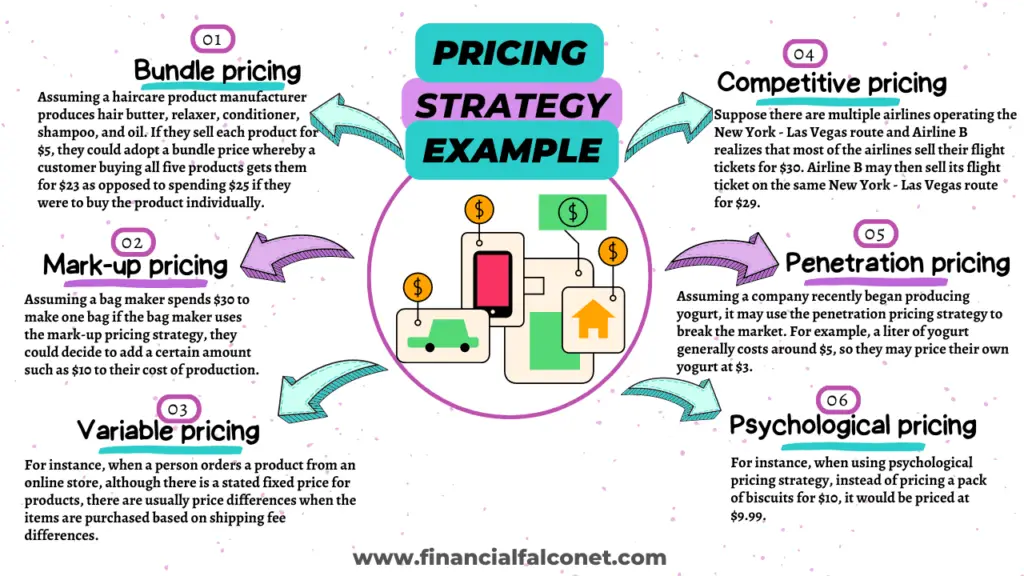Every manufacturer or service provider set the price of the products or services they provide based on several factors such as the cost of goods sold (COGS), purchasing power of their target market, price of competing companies, etc. They may also consider their bottom line at the end of each accounting period. In order to ensure profitability from adequate sales and have a considerable amount in retained earnings, businesses adopt one or a combination of two or more pricing strategies. In this article, we shall discuss some pricing strategy examples. Before we begin, let us define some keywords.
Read about: Process Costing System: Examples, Methods, and Steps
What is pricing?
Pricing refers to the process of fixing a specific monetary value that has to be paid by a person to purchase a good or service. When setting the price of products or services, manufacturers and service providers often consider how much they spent on raw materials, manufacturing costs, competitors’ pricing, and the level of demand, amongst many other criteria based on the company’s specific pricing strategy.
Pricing is very important as it has the potential of attracting or pushing away customers. It is an indicator that portrays to clients how much you value them, your brand, and the products or services you are offering.

What is a pricing strategy?
A pricing strategy refers to the model or method used by companies to determine the amount they will charge for their products or services. The pricing strategy differs from one manufacturer to another and from one service provider to the other. This is because several factors determine the particular pricing strategy that a business may choose. The pricing strategy provides a framework for making pricing decisions and guides how prices are set or adjusted over time.
The particular pricing strategy adopted and implemented by a company is dependent on several internal and external factors. Some of the internal factors include the cost of production, product quality, desired revenue, the amount spent on advertising, product attributes, etc. External factors would include the level of product or service demand, economic trends, and your competitors’ prices. Choosing the right pricing strategy is very important as it aids businesses in maximizing their shareholder value and profits while considering the market demand as well as the purchasing power of their target audience.
Read about: How to scale your business
Types of pricing strategies with examples
- Bundle pricing strategy
- Competitive pricing strategy
- Discount pricing strategy
- Freemium price strategy
- Luxury pricing strategy
- Mark-up pricing strategy
- Penetration pricing strategy
- Project-based pricing strategy
- Psychological pricing strategy
- Rate-based pricing strategy
- Skimming pricing strategy
- Time-based pricing strategy
- Value-based pricing strategy
- Variable pricing strategy
There are several pricing strategy examples based on the particular type of pricing strategy that a business uses. Listed above are various types of pricing strategies. We shall discuss each one below and also look at some pricing strategy examples.
Bundle pricing strategy
The bundle pricing strategy involves offering consumers a lower price when they buy products or services in groups or bundles. This pricing strategy is used by companies to make customers buy more products or services at once. It is also used to introduce consumers to complementary products or services that a business is selling. Companies that use a bundle strategy may sell the products either as individual products or as components of the bundle. However, the bundle package usually offers a lower price than when the product or service is purchased individually.
Bundle pricing strategy example
Assuming a haircare product manufacturer produces hair butter, relaxer, conditioner, shampoo, and oil. This company may choose to adopt the bundle pricing strategy to encourage their customers to buy all the hair products instead of buying just a single product. If for instance, they sell each product for $5, they could adopt a bundle price whereby a customer buying all five products gets them for $23 as opposed to spending $25 if they were to buy the product individually. By using this bundle pricing strategy, the company exposes its consumers to all its products. Hence, they are better able to increase sales and consequently, improve profitability too.
Competitive pricing strategy
The competitive pricing strategy involves setting prices in line with competitors, slightly below them, or offering additional incentives in order to attract price-sensitive customers. Thus, the price at which competitors offer their products or services becomes the benchmark used by the company to set their own selling price.
The goal is to offer a similar product or service at a more appealing price to gain a competitive advantage. This type of pricing strategy is often used by businesses that operate in an already saturated market, hence, a slight difference in price may be the tipping point for consumers to patronize one business instead of the other. The competitive pricing strategy is also known as competition or competitor-based pricing strategy.
Competitive pricing strategy example
Suppose there are multiple airlines operating the New York – Las Vegas route and Airline B realizes that most of the airlines sell their flight tickets for $30. Airline B may then sell its flight ticket on the same New York – Las Vegas route for $29. Thus by using this competitive pricing strategy of reducing $1 from the prevalent flight fare, Airline B can easily enjoy more patronage, especially from individuals that are price-conscious when purchasing flight tickets.
Discount pricing strategy
The discount pricing strategy is also referred to as the high-low pricing strategy. This involves charging a high price for a particular product and then reducing the price after some time either through clearance, year-end, or discount sales. The discount pricing strategy is mostly used by companies that sell items such as furniture, clothes, and decor. This is because these items often lose their novelty once a newer item is produced. Hence the companies aim to profit from a product’s novelty and relevance.
Additionally, high-low pricing may attract new customers who may not be able to afford the high price of the product. Therefore, they will wait for discount sales to be able to purchase such items at a lower price.

Discount pricing strategy example
Worldwide, discount sales have become quite popular over the years with a lot of individuals saving up to purchase several products at Black Friday sales. Various product manufacturers also use this period to offer between 10-50% discounts on the original price of a product that they make. This benefits both the company and the customers as the company can increase sales while clearing out their stores for newer products while customers can purchase previously expensive products at a cheaper rate.
Freemium price strategy
This type of pricing strategy is commonly used by software companies such as Canva and WordPress. These companies offer a free version and a premium version of the same product. Generally, the free version has limited access to the software’s functionality while the premium version offers additional features and functionality. Companies use this pricing strategy to offer consumers a peek into the software through the free version while encouraging upgrades and subscriptions to the premium version.
Companies that use this strategy often present a low barrier to entry by offering several different premium packages. The prices generally increase with an increase in access to features and functionality. This pricing strategy often increases a company’s premium customers in the long run and generally boosts its customer base.
Freemium price strategy example
The web content management system company, WordPress uses the freemium pricing strategy for its web content publishing platform. With this strategy, the company offers a free publishing platform with limited content. To encourage patronage for the paid publishing platform, it offers a wide range of options ranging from personal, premium, business, commerce, and enterprise. Each of these options offers more features than the previous one and charges a bit higher.
For instance, the first paid package on WordPress charges $5 monthly and $48 annually while the highest package (Enterprise) charges $25,000 annually but offers far more features and functionality.
Luxury pricing strategy
The luxury pricing strategy is often used by manufacturers of haute-couture, technology products, automobiles, yachts, and other prestige items. It is also used by service providers that provide certain exclusive services such as voyages, hotels, and clubs. The companies that use this pricing strategy do so as a means of distinguishing their products or services from others in the market. It also affords a mark of exclusivity, rareness, and luxury on a product or service.
This pricing strategy further focuses on the brand’s perception and awareness, and the perceived value of the product or service rather than its actual value. The luxury pricing strategy is also referred to as the premium or prestige pricing strategy.
Luxury pricing strategy example
An example of a company that uses the luxury pricing strategy is the automobile company, Rolls-Royce. This company produces luxury cars, with the Rolls-Royce Boat Tail selling at over $28 million. When compared to other car manufacturers, this price is extremely high and thus offers exclusivity and rareness to individuals who are able to purchase the Rolls-Royce Boat Tail.

Mark-up pricing strategy
The mark-up pricing strategy is the most commonly used type of pricing strategy. This pricing strategy is based on the cost of producing a good or service and adds up a certain percentage or amount to this Cost of goods sold (COGS) to determine their selling price. In essence, a company simply marks up a certain amount above its COGS and pegs it as the product or service selling price. The markup pricing strategy is also referred to as the cost-plus pricing strategy. It is mainly used by product retailers. The advantage of using this markup system is that a company can more accurately predetermine its expected profit ahead of sales.
Mark-up pricing strategy example
Assuming a bag maker spends $30 to make one bag if the bag maker uses the mark-up pricing strategy, they could decide to add a certain amount such as $10 to their cost of production. This would mean that the selling price of the bag would be $40. If they however choose to use a percentage mark-up of say 50%, then the bag will cost $45 since 50% of the production cost is $15.
Penetration pricing strategy
This type of pricing strategy involves setting the price of a good or service at an extremely low level as a means of breaking into the market and attracting customers away from other companies that offer similar products or services at a higher price. Startups often use this pricing strategy when starting out. Although they may incur losses at this initial stage, they will likely gain a considerable number of consumers who could patronize them in the future.
Penetration pricing strategy example
Assuming a company recently began producing yogurt, it may use the penetration pricing strategy to break the market. For example, if a liter of yogurt generally costs around $5, they may price their own yogurt at $3. This lower price although unsustainable in the long run can attract a considerable number of customers and aid them to effectively break into the market.
Project-based pricing strategy
The project-based pricing strategy is used by companies and individuals that charge a flat fee based on a service that would be rendered irrespective of how long it will take to complete the project. This is often based on the value of the project deliverables and not on the time spent on the project.
Project-based pricing strategy example
Assuming Mr. John hires a contractor to build him a house and the contractor charges him $50,000 for the work. Since the contractor charged him based on the work that will be done instead of the time that would be spent on the project, it means that the building contractor uses the project-based pricing strategy.
Psychological pricing strategy
This pricing strategy is anchored on using the psychological need to get the best deal from the money spent on a product or service. A common tactic used is pricing in dollars and cents instead of just dollars. Sometimes, a product could also be placed near a product that is more expensive to make its price look more affordable. Another tactic is to put a high price, cross it, and put a lower price; this is called price anchoring. An additional tactic is changing the font, size, and color of an item’s pricing information on and around the product. All these tactics are targeted toward human psychology to drive up patronage and increase sales.
Psychological pricing strategy example
For instance, when using psychological pricing strategy, instead of pricing a pack of biscuits for $10, it would be priced at $9.99. This is called charm pricing as people often feel a price is cheaper when it ends in 9 or 5.
Another psychological pricing strategy example is placing a $15.99 item close to a $30 item. This makes the former item seem like a really great deal to ignore and often leads to an increase in sales for the former item.
Rate-based pricing strategy
Rate-based pricing strategy is commonly used by contractors, consultants, freelancers, handymen, and other laborers who provide various services that can be charged based on the time spent in providing the service. Based on this, it is also referred to as the hourly pricing strategy. This strategy has been adopted widely in the United States by several companies that pay their employees an hourly rate.
Rate-based pricing strategy example
For example, in order to realize the best value from the time spent with clients, most therapists use the rate-based pricing strategy. They may charge clients an hourly rate of $10, this ensures that both the therapist and the clients make the most efficient use of the allotted time for each therapy session.
Skimming pricing strategy
The skimming pricing strategy refers to when businesses charge the highest possible price for a product or service and then lower its price gradually over time as the product or service becomes more common or less popular. It is designed to aid businesses to recoup their investments in a product or service in the least possible time before their competitors provide similar products or services.
This pricing strategy is commonly used by well-known brands or celebrities when they launch a new product or service. It differs from the discount pricing strategy as the price gets gradually reduced over time instead of being reduced at once at a discount sale. The skimming pricing strategy is also referred to as the skim-the-cream pricing strategy.
Skimming pricing strategy example
When a reputable mobile phone manufacturer, Apple produces a new iPhone version, it is often priced at a high amount. Early adopters are typically willing to pay this high amount so as to own the latest iPhone version. After the initial high-price phase, the company gradually lowers the price over time. This allows them to expand their customer base beyond the early adopters, attracting more price-sensitive consumers. As the price decreases, the product becomes more accessible to a wider market, increasing sales volume and market share. Furthermore, this gradual reduction in price enables manufacturers to cater to both early adopters and price-sensitive customers, thereby capturing the maximum value from each group of consumers.
Time-based pricing strategy
Time-based pricing strategy is a flexible type of pricing strategy where the price of goods and services fluctuates based on an increase or decrease in customer demand. It is commonly used by businesses and service providers whose demands change at different times of the year. This includes retailers of seasonal products such as fishing supply shops, Christmas decoration stores, and summer goods stores. Service providers such as airlines, event venues, car hire providers, and hotels also use this pricing strategy.
In order to use this type of pricing strategy, the companies that use them utilize algorithms that take into account factors such as demand, competitor pricing, and cost of production. These algorithms then provide price changes based on the factors mentioned earlier, thereby ensuring that the business is able to make more profits at times of higher demand. Time-based pricing strategy is also referred to as dynamic, demand, or surge pricing strategy.

Time-based pricing strategy example
A decoration store can use a time-based pricing strategy to determine the price of decorative items. This strategy is based on the surge of demand for decorative items during holiday seasons such as Halloween, Christmas, and Thanksgiving. Hence, during periods of high demand, the price of decorative items will be higher due to the surge in demand. While the price will be low when demand reduces. For instance, the cost of a Christmas tree may be $30 around Christmas time and become $20 after Christmas.
Value-based pricing strategy
The value-based pricing strategy is quite challenging to implement, this is because companies that use this pricing strategy price their products or services based on their perceived value to the consumer. The benefits which a consumer will derive from using the product or service as well as how much a customer is willing to pay are the major determining factors when using this pricing strategy. Hence, to effectively use this pricing strategy, the company has to make adequate research to understand the purchasing power of their target customer and how much they will be willing to pay for the product or service the company is selling.
Value-based pricing is often used by freelancers and companies that can effectively communicate the benefit to a consumer from using their product or service. It is also used when the products or services offered are highly differentiated and provide considerable value to the user.
Value-based pricing strategy example
A ghostwriter can use the value-based pricing strategy to charge clients. This is because when a ghostwriter writes a book for a person, although it is largely their intellectual property, they transfer ownership rights to the person for whom the book is written. This means that the client will enjoy royalties on the book sale for decades after it has been written and published. Thus, in order to benefit from their work, they charge the client based on the value that the client could derive from the book and not necessarily based on the cost of writing the book.
Variable pricing strategy
This is perhaps one of the most commonly used pricing strategies in use currently by companies. It takes into account several factors such as interest rates, geographical location, and shipping fee, among others when pricing a product.
Variable pricing strategy example
For instance, when a person orders a product on Aliexpress, although there is a stated fixed price for products, there are usually price differences when the items are purchased. The difference in product prices is often based on shipping fee differences.
Read about: What are Zombie Corporations? Definition and Effects
Conclusion
There are several pricing strategy examples based on the particular type of strategy that a company uses when pricing a product or service. We have discussed some of these examples here. Pricing strategy plays a crucial role in determining the success of a business. It involves setting the right price for a product or service to maximize profits, achieve market penetration, or position the brand strategically. The particular pricing strategy that a company uses depends on its sales and financial goals.
Last Updated on November 2, 2023 by Nansel Nanzip BongdapBlessing's experience lies in business, finance, literature, and marketing. She enjoys writing or editing in these fields, reflecting her experiences and expertise in all the content that she writes.

